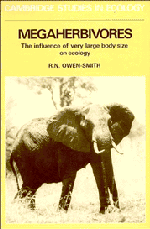Book contents
- Frontmatter
- Contents
- Preface
- 1 Prologue
- 2 Morphology, evolutionary history and recent distribution
- 3 Food and other habitat resources
- 4 Space–time patterns of habitat use
- 5 Body size and nutritional physiology
- 6 Body size and feeding ecology
- 7 Social organization and behavior
- 8 Life history
- 9 Body size and sociobiology
- 10 Body size and reproductive patterns
- 11 Demography
- 12 Community interactions
- 13 Body size and population regulation
- 14 Body size and ecosystem processes
- 15 Late Pleistocene extinctions
- 16 Conservation
- 17 Epilogue: the megaherbivore syndrome
- Appendixes
- References
- Index
13 - Body size and population regulation
Published online by Cambridge University Press: 01 June 2011
- Frontmatter
- Contents
- Preface
- 1 Prologue
- 2 Morphology, evolutionary history and recent distribution
- 3 Food and other habitat resources
- 4 Space–time patterns of habitat use
- 5 Body size and nutritional physiology
- 6 Body size and feeding ecology
- 7 Social organization and behavior
- 8 Life history
- 9 Body size and sociobiology
- 10 Body size and reproductive patterns
- 11 Demography
- 12 Community interactions
- 13 Body size and population regulation
- 14 Body size and ecosystem processes
- 15 Late Pleistocene extinctions
- 16 Conservation
- 17 Epilogue: the megaherbivore syndrome
- Appendixes
- References
- Index
Summary
Introduction
For an expanding population to be transformed into a stable one, density dependent changes must occur either in rates of recruitment, in population losses, or in both (Caughley 1977). Recruitment can decline due to (i) a decline in female fecundity, brought about by reduced litter sizes, or increased intervals between births; (ii) higher post-natal losses; or (iii) ages at first parturition being retarded. Losses can increase due to (i) increased mortality, whether as the direct result of nutritional deficiencies, or as a result of predation or disease; or (ii) to increased emigration from the area.
Caughley & Krebs (1983) suggested that there is a fundamental dichotomy between the processes of population regulation in small mammals (under about 30 kg in body mass), and those operating in larger mammals. The former are regulated mainly by intrinsic mechanisms, i.e. by behavioral or physiological responses acting before food becomes limiting. In contrast, large mammals are regulated largely by extrinsic factors, such as the direct effects of food limitations on survival and reproduction.
Goodman (1981) emphasized that the population dynamics of large, long-lived mammals are much more sensitive to variations in annual survival rates than to corresponding variations in fecundity. These circumstances favor deferred reproduction as an adaptive response to adverse conditions.
Riney (1964) maintained that populations of large herbivores expanding from low densities in favorable habitats inevitably overshoot the carrying capacity of the vegetation.
- Type
- Chapter
- Information
- MegaherbivoresThe Influence of Very Large Body Size on Ecology, pp. 246 - 264Publisher: Cambridge University PressPrint publication year: 1988



